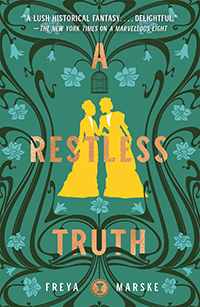Kell Woods’ second historical fantasy, Upon a Starlit Tide, is clearly inspired by classic stories such as “The Little Mermaid,” “Cinderella” and “Bluebeard”—but similar tropes is where the resemblance ends, as Woods has molded these elements into an original fairy tale all her own.
Lucinde Léon, one of three daughters of famed and revered Breton merchant Jean-Baptiste Léon, has always felt an inexplicable pull towards the ocean, one that her father encourages. Luce is used to doing things unconventionally: She spends her time at a sea cave watched over by a groac’h (a water fairy who stands in for the sea-witch from “The Little Mermaid”) and harbors strong emotions for her smuggler friend Samuel, a tattooed English sailor whom she’s convinced to teach her how to sail. As a naval war between the French and English rages on and Luce and her sisters are due to be married off to claim their places in society, her rose-colored views of their home, picturesque Saint-Malo, are being put to the test. She must make some difficult decisions about who to love, who to trust and who to protect—especially after saving a handsome, near-drowned sailor, Morgan de Chatelaine, unearths more mysteries than ever.
How Kell Woods combined two classic fairy tales to create a magic all her own.
Upon a Starlit Tide creatively fuses elements of beloved tales to construct a wholly new world to immerse readers in. Gone is the typical fairy godmother, who is here replaced by a friendly lutine (a type of flower hobgoblin). Likewise, the groac’h has more secrets to her than meets the eye, overturning the typically villainous narrative. As with her previous novel, After the Forest, Woods celebrates femininity, heroines giving into their wild nature and femmes taking agency of their own lives to pursue their happily ever after. Readers will root for Luce whether she is in the throes of a love triangle between Samuel and Morgan, or in the throes of the unpredictable, tempestuous sea. Woods also provides countless wonderful descriptions of the fae, which lends an ethereal nature to Saint-Malo and makes the sad reality of the fairy folk’s exodus from Brittany (due to humans stealing their magic, their livelihood and their homes) hit all the harder.
With beautifully flowing prose and countless twists, Woods concocts a tale of love, betrayal and revenge that will drag unsuspecting readers along with its currents. One may recognize elements that feel fitting for a traditional fairy tale—a parent’s hidden secrets, a dashing stranger who seems too good to be true. And in Luce herself, they may also recognize a part of themselves that yearns to be set free to explore the world, following their heart’s desire, unfettered by society’s requirements and expectations.


















